Last week I wrote that it’s important to look for the surface roots when evaluating bonsai (see “Check the surface roots“). What is it that we’re looking for?
We want to see the connection between trunk and roots.

Surface roots on corkbark elm
When we see surface roots – nebari, in Japanese – we can get a sense of how secure the bonsai is in its growing medium. The roots not only secure bonsai in place, they are the vehicle through which the tree can interact with the soil – a key part of the tree’s existence.
The role surface roots play can differ from variety to variety. Often collected bonsai, particularly junipers, emerge between cracks in rocks. This leaves no opportunity for the tree to develop surface roots. For this reason, it’s acceptable for otherwise excellent trees to lack surface roots.
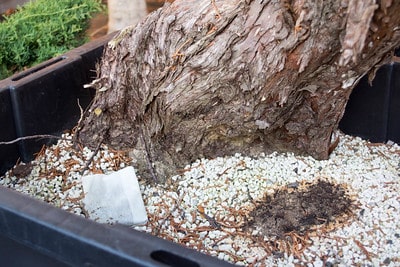
No surface roots – Sierra juniper collected from between rocks
Other times surface roots are a jumble. In these cases our best hope is that there is no evidence of reverse taper.
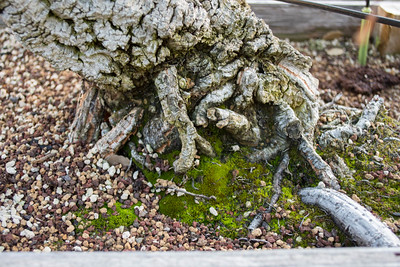
Surface roots on cork oak
Many trees grown as bonsai for a long time are repeatedly planted too high. In these cases, you might find surface roots that look like they’re sitting on top of the soil or floating in the air.
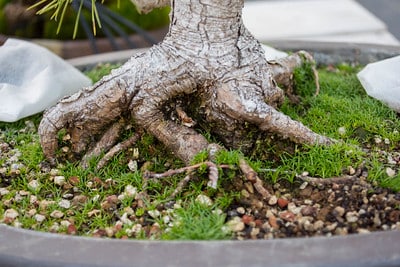
Surface roots above the surface of the soil
In these cases, we can improve the appearance of the surface roots by planting the tree lower in the pot.
Sometimes roots can display the characteristics we most appreciate in the trunk of the tree. For pines, this would be fissured bark.
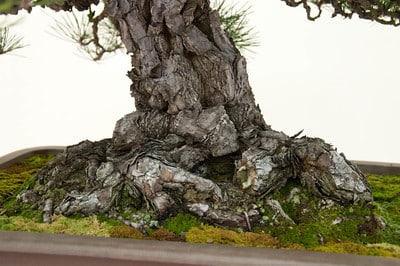
Aged bark on the surface roots of a black pine
The appearance of lichen can also convey a sense of great age. This is often the case for white pine bonsai.
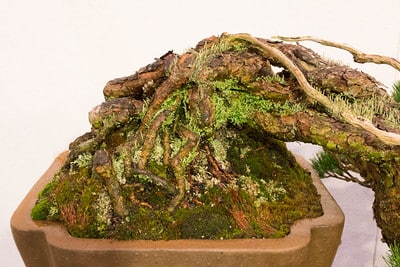
Surface roots with lichen on white pine
In general, surface roots are very important on deciduous bonsai. One reason for this is that it’s easier to develop surface roots on deciduous trees than it is to develop them on conifers. The appearance of these roots, however, can vary widely depending on the species.
A good non-typical example is stewartia bonsai. Over time, old stewartia bonsai develop knuckles where the roots enter the soil. We don’t think of this as a flaw because stewartia naturally grow this way.
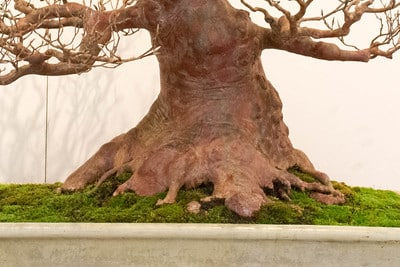
Surface roots on stewartia bonsai
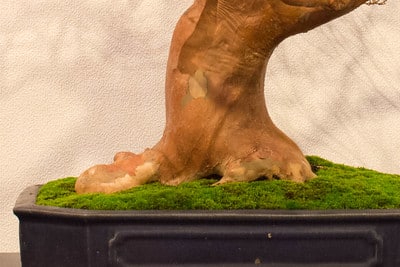
Large knuckles on stewartia bonsai
Maples, on the other hand, readily develop great surface roots. Because of this, our standards for maple bonsai nebari are high.
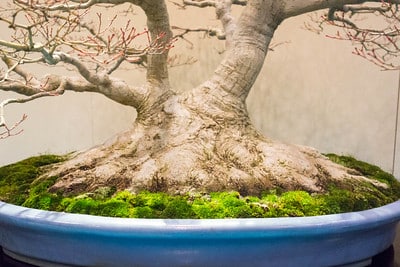
Nebari on Japanese maple
In many cases, the surface roots on deciduous varieties greatly contribute to the initial taper of the trunk.
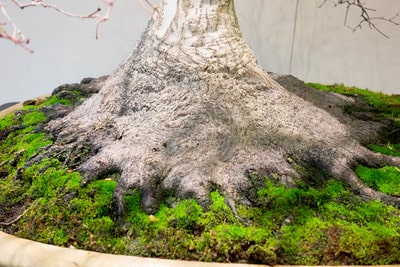
Surface roots on Japanese maple contributing to the flair of the trunk
The most extraordinary examples are spectacular.
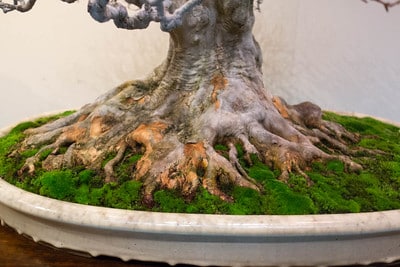
Surface roots on trident maple
Subscribe to Bonsai Tonight
New Posts Delivered Every Tuesday and Friday
Patricia in Glens Falls NY says
Great segments on tree selection with good explanations supported by appropriate pictures of good quality. Thank you for your efforts on this topic.
Paul says
Maybe a future article could be how to create or methods of improvement of existing nebari?
Jonas Dupuich says
Thanks Paul, great idea. I’ve written a bit on this in the past – here’s one of the more interesting examples: https://bonsaitonight.com/2011/06/10/the-best-repotting-of-the-year/
endsurg says
Great post, Jonas, on a topic that receives too little attention. I know that nebari are very important but I know so little about developing them. Could you address how to manage nebari that cross other nebari? How do I remove an ugly nebari without affecting the portion of the tree that it supplies? I just dug up a shimpaku and will repot it in January. However, there is one major surface root that crosses other nebari. When is the correct time to address this problem? and how is it done?
Jonas Dupuich says
Thanks! Good question about crossing roots – in general, cut the root that crosses other roots. The best time to do this work is during repotting when you can get a good idea of how much each major root is doing to support the tree. If, however, 90% of the roots are connected to the crossing root, other approaches are needed.
If you post a photo of the shimpaku surface roots to http://ask.bonsaitonight.com we may be able to provide specific advice for your tree.
carterbeall says
I often see young seedlings used for root grafts on maples. Where do these usually come from? Are they seedlings or cuttings from the same tree or are they nursery stock? How important is it that the tree used is genetically identical? I understand that most things under the same genus will fuse, and most maples have the same bark. I am hoping to do some root grafts, but I would prefer to buy some young whips to growing some from seed.
Jonas Dupuich says
Good question about the root scions. Most of the root grafting I’ve seen uses seedlings grown from different parent trees. On occasion there may be a significant difference between the new and existing roots, but in general the differences are minor or nonexistent. The young trees used for root grafting are typically nursery-grown stock.